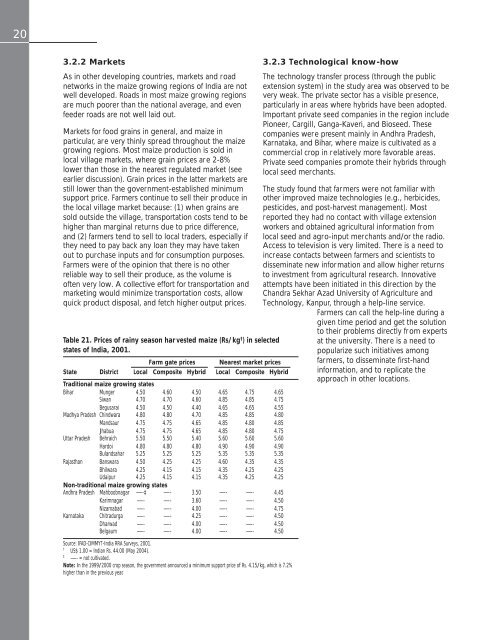Maize in India: Production Systems, Constraints - AgEcon Search
Maize in India: Production Systems, Constraints - AgEcon Search
Maize in India: Production Systems, Constraints - AgEcon Search
You also want an ePaper? Increase the reach of your titles
YUMPU automatically turns print PDFs into web optimized ePapers that Google loves.
20<br />
3.2.2 Markets<br />
As <strong>in</strong> other develop<strong>in</strong>g countries, markets and road<br />
networks <strong>in</strong> the maize grow<strong>in</strong>g regions of <strong>India</strong> are not<br />
well developed. Roads <strong>in</strong> most maize grow<strong>in</strong>g regions<br />
are much poorer than the national average, and even<br />
feeder roads are not well laid out.<br />
Markets for food gra<strong>in</strong>s <strong>in</strong> general, and maize <strong>in</strong><br />
particular, are very th<strong>in</strong>ly spread throughout the maize<br />
grow<strong>in</strong>g regions. Most maize production is sold <strong>in</strong><br />
local village markets, where gra<strong>in</strong> prices are 2-8%<br />
lower than those <strong>in</strong> the nearest regulated market (see<br />
earlier discussion). Gra<strong>in</strong> prices <strong>in</strong> the latter markets are<br />
still lower than the government-established m<strong>in</strong>imum<br />
support price. Farmers cont<strong>in</strong>ue to sell their produce <strong>in</strong><br />
the local village market because: (1) when gra<strong>in</strong>s are<br />
sold outside the village, transportation costs tend to be<br />
higher than marg<strong>in</strong>al returns due to price difference,<br />
and (2) farmers tend to sell to local traders, especially if<br />
they need to pay back any loan they may have taken<br />
out to purchase <strong>in</strong>puts and for consumption purposes.<br />
Farmers were of the op<strong>in</strong>ion that there is no other<br />
reliable way to sell their produce, as the volume is<br />
often very low. A collective effort for transportation and<br />
market<strong>in</strong>g would m<strong>in</strong>imize transportation costs, allow<br />
quick product disposal, and fetch higher output prices.<br />
Table 21. Prices of ra<strong>in</strong>y season har vested maize (Rs/kg † ) <strong>in</strong> selected<br />
states of <strong>India</strong>, 2001.<br />
Farm gate prices Nearest market prices<br />
State District Local Composite Hybrid Local Composite Hybrid<br />
Traditional maize grow<strong>in</strong>g states<br />
Bihar Munger 4.50 4.60 4.50 4.65 4.75 4.65<br />
Siwan 4.70 4.70 4.60 4.85 4.85 4.75<br />
Begusarai 4.50 4.50 4.40 4.65 4.65 4.55<br />
Madhya Pradesh Ch<strong>in</strong>dwara 4.80 4.80 4.70 4.85 4.85 4.80<br />
Mandsaur 4.75 4.75 4.65 4.85 4.80 4.85<br />
Jhabua 4.75 4.75 4.65 4.85 4.80 4.75<br />
Uttar Pradesh Behraich 5.50 5.50 5.40 5.60 5.60 5.60<br />
Hardoi 4.80 4.80 4.80 4.90 4.90 4.90<br />
Bulandsahar 5.25 5.25 5.25 5.35 5.35 5.35<br />
Rajasthan Banswara 4.50 4.25 4.25 4.60 4.35 4.35<br />
Bhilwara 4.25 4.15 4.15 4.35 4.25 4.25<br />
Udaipur 4.25 4.15 4.15 4.35 4.25 4.25<br />
Non-traditional maize grow<strong>in</strong>g states<br />
Andhra Pradesh Mahboobnagar —-‡ —- 3.50 —- —- 4.45<br />
Karimnagar —- —- 3.60 —- —- 4.50<br />
Nizamabad —- —- 4.00 —- —- 4.75<br />
Karnataka Chitradurga —- —- 4.25 —- —- 4.50<br />
Dharwad —- —- 4.00 —- —- 4.50<br />
Belgaum —- —- 4.00 —- —- 4.50<br />
Source: IFAD-CIMMYT-<strong>India</strong> RRA Surveys, 2001.<br />
†<br />
US$ 1.00 = <strong>India</strong>n Rs. 44.00 (May 2004).<br />
‡<br />
—- = not cultivated.<br />
Note: In the 1999/2000 crop season, the government announced a m<strong>in</strong>imum support price of Rs. 4.15/kg, which is 7.2%<br />
higher than <strong>in</strong> the previous year.<br />
3.2.3 Technological know-how<br />
The technology transfer process (through the public<br />
extension system) <strong>in</strong> the study area was observed to be<br />
very weak. The private sector has a visible presence,<br />
particularly <strong>in</strong> areas where hybrids have been adopted.<br />
Important private seed companies <strong>in</strong> the region <strong>in</strong>clude<br />
Pioneer, Cargill, Ganga-Kaveri, and Bioseed. These<br />
companies were present ma<strong>in</strong>ly <strong>in</strong> Andhra Pradesh,<br />
Karnataka, and Bihar, where maize is cultivated as a<br />
commercial crop <strong>in</strong> relatively more favorable areas.<br />
Private seed companies promote their hybrids through<br />
local seed merchants.<br />
The study found that farmers were not familiar with<br />
other improved maize technologies (e.g., herbicides,<br />
pesticides, and post-harvest management). Most<br />
reported they had no contact with village extension<br />
workers and obta<strong>in</strong>ed agricultural <strong>in</strong>formation from<br />
local seed and agro-<strong>in</strong>put merchants and/or the radio.<br />
Access to television is very limited. There is a need to<br />
<strong>in</strong>crease contacts between farmers and scientists to<br />
dissem<strong>in</strong>ate new <strong>in</strong>for mation and allow higher returns<br />
to <strong>in</strong>vestment from agricultural research. Innovative<br />
attempts have been <strong>in</strong>itiated <strong>in</strong> this direction by the<br />
Chandra Sekhar Azad University of Agriculture and<br />
Technology, Kanpur, through a help-l<strong>in</strong>e service.<br />
Farmers can call the help-l<strong>in</strong>e dur<strong>in</strong>g a<br />
given time period and get the solution<br />
to their problems directly from experts<br />
at the university. There is a need to<br />
popularize such <strong>in</strong>itiatives among<br />
farmers, to dissem<strong>in</strong>ate first-hand<br />
<strong>in</strong>formation, and to replicate the<br />
approach <strong>in</strong> other locations.

















